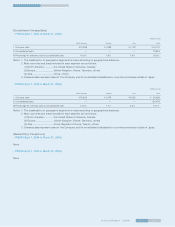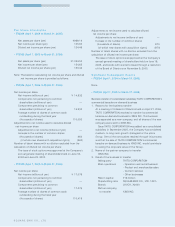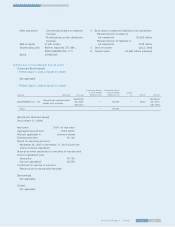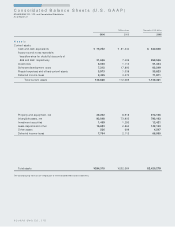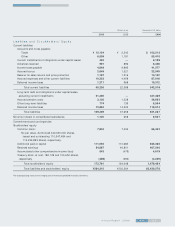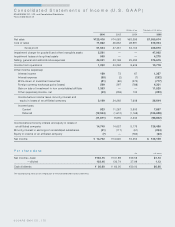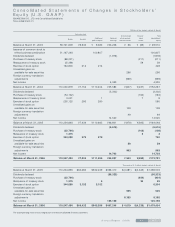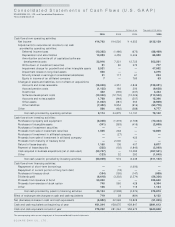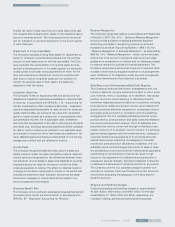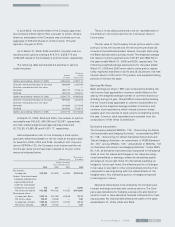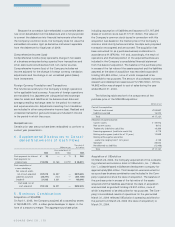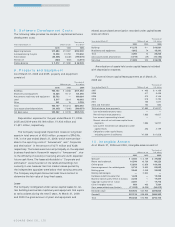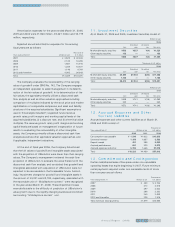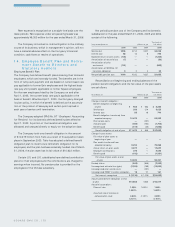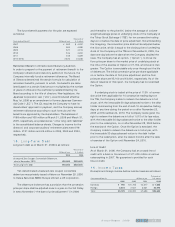Square Enix 2006 Annual Report Download - page 53
Download and view the complete annual report
Please find page 53 of the 2006 Square Enix annual report below. You can navigate through the pages in the report by either clicking on the pages listed below, or by using the keyword search tool below to find specific information within the annual report.
5 0 5 1
A n n u a l R e p o r t 2 0 0 6
implied fair value of each reporting unit using discounted cash
flow analysis and compares such values to the respective report-
ing unit’s carrying amount. The Company performs its annual
test for indication of goodwill impairment in the fourth quarter
of each fiscal year.
Impairment of Long-Lived Assets
The Company evaluates its long-lived assets for impairment as
events or changes in circumstances indicate that the carrying
amount of such assets may not be fully recoverable. The Com-
pany evaluates the recoverability of long-lived assets by mea-
suring the carrying amount of the assets against the estimated
undiscounted future cash flows associated with them. At the
time such evaluations indicate that the future undiscounted
cash flows of certain long-lived assets are not sufficient to
recover the carrying value of such assets, the assets are
adjusted to their fair values.
Investment Securities
The Company invests in equity securities and bonds, and has
classified its investment securities as available-for-sale and held-
to-maturity, in accordance with SFAS No. 115 “ Accounting for
Certain Investments in Debt and Equity Securities.” Investment
securities designated as available-for-sale, whose fair values are
readily determinable, are carried at fair value with unrealized
gains or losses included as a component of accumulated other
comprehensive income, net of applicable taxes. Investment
securities that are expected to be held-to-maturity are carried at
amortized cost. Individual securities classified as either available-
for-sale or held-to-maturity are reduced to net realizable value
by a charge to income for other than temporary declines in fair
value. Realized gains and losses are determined on the moving
average cost method and are reflected in income.
Income Taxes
The Company recognizes deferred taxes using the asset and
liability method. Under the asset and liability method, deferred
income taxes are recognized for the differences between finan-
cial statement and tax bases of assets and liabilities at currently
enacted statutory tax rates for the years in which the differ-
ences are expected to reverse. The effect on deferred taxes for
a change in tax rates is recognized in income in the period that
includes the enactment date. Valuation allowances are estab-
lished when necessary to reduce deferred tax assets to the
amounts expected to be realized.
Employee Benefit Plan
The Company and its domestic subsidiaries have defined benefit
retirement plans, which are accounted for in accordance with
SFAS No. 87 “ Employers’ Accounting for Pensions” .
Revenue Recognition
The Company recognizes revenue in accordance with Statement
of Position (“ SOP” ) No. 97-2, “ Softw are Revenue Recognition” ,
which provides guidance on applying generally accepted
accounting principles in recognizing revenue on software
transactions and Staff Accounting Bulletin (“ SAB” ) No.101,
“Revenue Recognition in Financial Statements” , as amended by
SAB No. 104, “ Revenue Recognition” , which outline the basic
criteria that must be met to recognize revenue and provides
guidance for presentation of revenue and for disclosure related
to revenue recognition policies in financial statements. The
Company recognizes revenue when the price is fixed and deter-
minable, when there is persuasive evidence of an arrangement,
upon fulfillment of its obligations under any such arrangement
and when determination that collection is probable.
Sales Returns and Allowances and Bad Debt Reserves
The Company’s software distribution arrangements with cus-
tomers in Japan do not give customers the right to return prod-
ucts; however, the U.S. subsidiary, at its discretion, may accept
product returns for stock balancing or defective products,
sometimes negotiates accommodations to customers, including
price discounts, credits and product returns, when demand for
specific products falls below expectations, and accepts returns
and grants price protection in connection with its publishing
arrangements. The U.S. subsidiary estimates potential future
product returns, price protection and sales incentives related to
the current period product revenue. The U.S. subsidiary ana-
lyzes historical returns, current sell-through of distributor and
retailer inventory of its products, current trends in the software
games business segment and the overall economy, changes in
customer demand and acceptance of its products and other
related factors when evaluating the adequacy of the sales
returns and price protection allowances. In addition, the U.S.
subsidiary monitors and manages the volume of sales to retail-
ers and distributors and monitors their inventories as substantial
overstocking in the distribution channel can result in high
returns or the requirement for substantial price protection in
subsequent periods. Similarly, significant judgment is required
to estimate the allowance for doubtful accounts in any period.
The Company and the U.S. subsidiary analyze customer con-
centrations, customer credit-worthiness and current economic
trends when evaluating the adequacy of the allowance for
doubtful accounts.
Shipping and Handling Charges
Outbound shipping and handling charges of approximately
¥1,623 million, ¥634 million and ¥545 million for the year
ended March 31, 2006, 2005 and 2004, respectively, are
included in selling, general and administrative expenses.


